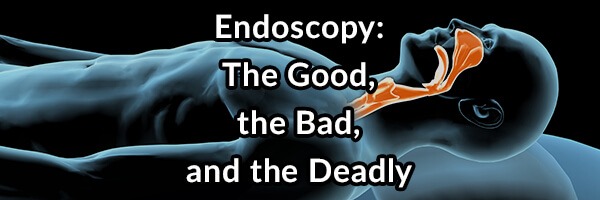Endoscopy What Your Doctor Does Not Inform You About the Procedure and How to Recover
Endoscopy procedures are frequently performed in people with gut issues. Many people that I have coached have had the procedure carried out to try to determine the extent of their gut issues. Their gastroenterologist or surgeon tells them that the procedure has little risk and that they perform many procedures with little to no problem. For most people, this may be true, but there are higher risks involved with endoscope procedures than your doctor leads you to believe, and even a safer scope can be done. Learn from the following blog and the above Youtube video on how to properly weigh the benefits and risks of this procedure and how to recover after having one performed quickly.
What Happens During An Endoscopy
An endoscopy is a procedure in which a flexible tube is inserted into the esophagus, stomach, or duodenum to evaluate its function and health. The tube has a light, forceps, and a camera on the end of the tube that shows video and can take pictures during the procedure. The doctor views the video on a monitor to help guide the tube and to make observations. Biopsies of the duodenum, stomach, esophagus, and larynx may occur during the endoscopy. Microbiome cultures and histology (cellular studies) may be performed on the biopsied tissue to determine your digestive health issues. Finally, endoscopy procedures are generally used in the diagnosis of GERD, LERD, bile reflux, Barrett’s esophagus, ulcers, H. pylori dysbiosis, and gastritis.1 2
You will be restricted from eating anything for eight hours before the procedure, and no liquids for four hours prior. Most people will be asked to fast after dinner the night before if your procedure is the next morning. Proper fasting before an endoscopy will help protect you from aspiration or vomiting. You will be sedated more than likely during the procedure, and your oral cavity and esophagus will be numbed (usually from an applied lidocaine spray) before the procedure. For an endoscopy procedure to view the upper gut, you will lie on your back, and the healthcare professional will insert the endoscope into your oral cavity, and the scope will move down your esophagus, and into your stomach or duodenum if needed. Air may be pumped into your digestive tract to help the endoscope move more freely, which may create bloating and belching after the procedure. For most people, an endoscopy procedure will last thirty minutes, and you will have to stay in the recovery area for at least an hour to make sure no complications arise from the procedure. Someone will have to drive you home afterward because of the use of sedation may make you drowsy for a while afterward.3 4
Common reported complications of the procedure are bleeding (maybe cauterized during the procedure if severe enough), aspiration (risk is reduced if you do not eat or drink at least twelve hours before the procedure), esophageal scarring, bloating, belching, pain, inflammation, and very rarely esophageal rupture. If the endoscope is inserted into the stomach or the duodenum bleeding or perforation may rarely occur. Endoscopies are important in determining the condition of the esophagus (evaluating damage from reflux, diagnosing swallowing issues, diagnosing cancer), the larynx (voice problems and the functionality of the lower esophageal sphincter, and conditions of the stomach and duodenum [ulcers, perforations, cancer]).5 6
So What Risks Does Your Gastroenterologist Not Emphasize
Two risks that are downplayed by most gastroenterologists that I believe are the under-reported issues of sedation and infection. Endoscopy procedures are performed with anesthesia and sedated GI endoscopy death rates have risen since the 1970s, from 5:100,000 to 14:100,000 today. According to Dr. Jamie Koufman, a silent reflux expert:7
“Since 1975, after almost 400 million sedated endoscopies and as many as 55,000 endoscopy-related deaths (398,000,000 procedures x 0.00014 (reported death rate) = 55,720 deaths). (BTW, I recognize that not all of those procedures were EGDs, so perhaps the actual EGD number of deaths is closer to 25,000 (1975 to the present).”8
Deaths from sedation endoscopy procedures have increased. However, it could be due to more procedures being performed. The famous comedian Joan Rivers tragically died during a standard sedated endoscopy. River’s was reported to have been suffering from reflux and voice issues. Even though the risk of death from sedation is small, I still feel that it is worth mentioning because most endoscopy procedures can be performed transnasally which does not require sedation.9 10
Infections occurring from improperly cleaned scoped instruments are on the rise. The U.S. FDA (Federal Drug Administration) and CDC (Center for Disease Control) have issued statements that infections have occurred and are increasing from instruments used in endoscopy procedures. Three hundred and fifty patients in the U.S. and worldwide were infected or exposed to tainted gastrointestinal scopes from 2010 to 2015. Endoscopic retrograde cholangiopancreatography procedures have been implicated in a greater cause of infection. Even standard duodenoscopy procedures have been involved in spreading Hepatitis C and MRSA.11 12 13 14
“When clinically significant bacterial infections are transmitted endoscopically, they are often recognized because their incubation periods are often short, and patients usually develop overt clinical symptoms. However, cases of transmission may be missed if the illness is subclinical or if symptoms are attributed to other factors associated with the procedure (issues related to the interventions performed or to sedation) or to other patient-specific conditions or events. Overall, although accurate data on infection transmission rates are difficult to obtain because of the lack of a proper mechanism for reporting and calculation of transmission rates, a summary of the available data, in the context of these reporting limitations, is provided below.
A total of 84 cases of endoscopy-related transmission of Salmonella species between patients were reported between 1974 and 1987, 7-15 but none have been reported since that time. Overall, there have been rare reports of endoscopic transmission of Pseudomonas species.
As recently as 2011, 4 patients who underwent upper endoscopy were found to be infected with multidrug resistant Pseudomonas. Several potential causes for the transmission were identified, including insufficient initial cleaning, shortening of immersion and brushing times, insufficient channel flushing, and inadequate drying before storage. In addition to inadequate reprocessing of the endoscope itself, the propensity for organism growth in moisture rich environments is a common factor in facilitating transmission. In some instances, an unsterilized irrigation water bottle attached to the endoscope was identified as a source of infection. A lack of cleaning and drying of the air-water and/or the elevator channels of duodenoscopes also was implicated in some cases of transmission of Pseudomonas infection. Failure of automated endoscope washer-dryers has been implicated in several cases.
Recently, a strain of Pseudomonas with reduced susceptibility to glutaraldehyde was reported. A few reports of endoscopic transmission of Helicobacter pylori
were attributed to inadequate reprocessing of endoscopes and biopsy forceps. Up to 61% of endoscopes became contaminated after use in patients infected with H pylori, but conventional cleaning and disinfection of the instruments are highly effective in eliminating H pylori. Before widespread application of standardized reprocessing guidelines, there were isolated reports of endoscopic transmission of other enteric bacteria, including Klebsiella, Enterobacter, Serratia, and Staphylococcus.
There have been no reports of transmission of mycobacteria by GI endoscopy. Current reprocessing guidelines were shown to be adequate in eradicating mycobacteria, and to date there are no reports of transmission of mycobacteria by GI endoscopy.
Similarly, reprocessing under the current guidelines was shown to inactivate biofilm and the spores of Clostridium difficile and other bacteria, and no cases of transmission of C difficile have been reported. As mentioned previously, transmission of MDROs, including CRE, via duodenoscopes, has been reported.
Unlike prior outbreaks of endoscope-transmitted infections, no recognized breaches of standard reprocessing protocol have been identified in outbreaks of duodenoscope-associated CRE to date. These transmissions seem to be related to difficult-to-clean or even sealed portions of these specific endoscopes, particularly the areas around the elevator regions of duodenoscopes.
There are rare reports of transmission of hepatitis C in situations where lapses in HLD of endoscopes occurred.
A single report documented transmission of the parasite Strongyloides to 4 patients from a contaminated instrument.“15
Standard endoscopy procedures are less likely to spread infection but have been documented and reported to occur. The infections have been blamed on scopes that are not adequately autoclaved or disinfected. Infectious agents can survive in the folds of an improperly cleaned scope and cause issues. Many scope instruments cannot be autoclaved (the extreme heat can damage them), so instead, they have to be disinfected by chemical methods and manual cleaning which may reduce infectious colonies but not fully sterilize the instruments, spreading infections. Harsh disinfecting chemicals might also cause unusual hypersensitive allergic reactions in people who have an endoscopy performed with chemically cleaned scopes. Hydrogen peroxide has been suggested to sterilize instruments, with little chance of allergic potential correctly. Biofilm colonies have also been shown to colonize scopes, making them harder to be cleaned as well. Finally, a few people that I have coached have noticed worsening gastrointestinal systems after these procedures, including increased overgrowth issues (bloating, pain, dyspepsia) It is possible that the scopes either introduced a new infectious agent or causes inflammation that helped enhance their current dysbiosis, causing worsening symptoms. Infections can also occur if the hands of the person who are being used to control the scope are not cleaned and wearing gloves. Finally, all surfaces in the procedure room should be cleaned and disinfected at the end of the day to prevent the spread of infection.16 17 18 19
Can Endoscopy Procedures be Safer?
Yes, for most people a transnasal esophagoscopy can be performed, which is a safer procedure to scope the larynx, esophagus, lower esophageal sphincter, upper esophageal sphincter, and the stomach. Most ear nose and throat (ENT) doctors can carry out this process, but I would ask your gastroenterologist as well if it can be done. During a transnasal esophagoscopy, a tube is inserted into the nasal cavity instead of the throat and is fed down into the esophagus and possibly the stomach if needed. The procedure is safer; no sedation is needed, just a numbing of the nose and throat. The spread of infection is less than a standard endoscope, but may still occur. A very inexpensive “condom” could be used to help reduce infections, but at this time is not used by gastroenterologists to protect against the spread of disease. Transnasal esophagoscopy does have limitations; it cannot scope the duodenum and biliary region, which an actual duodenoscopy or endoscopy might be required. If you are suffering from any type of reflux, a transnasal esophagoscopy might be all you need. If you are suffering from duodenal or biliary issues, you might need duodenoscopy or endoscopy, instead.20
If you need to have an endoscopy performed I only ask that you weigh the benefits and consequences of having the procedure performed and try to get a transnasal esophagoscopy done instead. Infections from scope instruments will continue to increase sadly as microbes become resistant to disinfection and sanitation methods. I hope some temporary barrier or better cleaning methods (possibly UV sterilization or silver embedded scopes) can be used to reduce the risk of contracting an infection. The risk of sedation is a minor risk, but a greater number of people are becoming sensitive to anesthesia per statistics (might be occurring from increased known or unknown interactions with medications people are taking). Endoscopy procedures are a necessary evil, but sometimes need to be performed to improve diagnosis and protocol recommendations. The procedures I believe can be made safer, and I hope doctors, researchers, and health care providers will take my considerations to improve the safety of the procedure in the future.
- Pagrana, Kathleen, Pagana, Timothy. Mosby’s Diagnostic and Laboratory Test Reference, Mosby, October 5, 2012. ↩
- Beers, Mark. The Merck Manual, Merck Research Laboratories, 2006. ↩
- Pagrana, Kathleen, Pagana, Timothy. Mosby’s Diagnostic and Laboratory Test Reference, Mosby, October 5, 2012. ↩
- Beers, Mark. The Merck Manual, Merck Research Laboratories, 2006. ↩
- Pagrana, Kathleen, Pagana, Timothy. Mosby’s Diagnostic and Laboratory Test Reference, Mosby, October 5, 2012. ↩
- Beers, Mark. The Merck Manual, Merck Research Laboratories, 2006. ↩
- http://transnasalesophagoscopy.com/tne-today ↩
- http://transnasalesophagoscopy.com/tne-today ↩
- http://transnasalesophagoscopy.com/tne-today ↩
- http://www.nydailynews.com/life-style/health/joan-rivers-died-predictable-complication-medical-examiner-article-1.1976873 ↩
- https://www.ncbi.nlm.nih.gov/pubmed/24451088 ↩
- http://www.latimes.com/business/la-fi-0415-olympus-scopes-20160414-story.html ↩
- http://cmr.asm.org/content/26/2/231.long ↩
- https://blogs.fda.gov/fdavoice/index.php/2015/02/bacterial-infections-associated-with-duodenoscopes-fdas-actions-to-better-understand-the-problem-and-what-can-be-done-to-mitigate-it/ ↩
- https://www.asge.org/docs/default-source/education/practice_guidelines/doc-51e78060-cd85-4281-b100-6abebcb04c49.pdf ↩
- https://www.ncbi.nlm.nih.gov/pubmed/24451088 ↩
- http://cmr.asm.org/content/26/2/231.long ↩
- https://www.researchgate.net/publication/288305771_Unsedated_transnasal_esophagoscopy_A_sensitive_and_safe_outpatient_screening_tool ↩







John,
I can relate to this one. I had an upper endoscopy about three months ago to break up a Schatzki’s ring that caused food impaction (and a night in the hospital). I had virtually no GI symptoms before the procedure. Now, I have frequent bloating, uncomfortable belching and pressure in my throat, and persistent globus sensation. Any recommendations for specific tests or next steps? Besides the ones you mention in this post, are you aware of any reasons that GI symptoms could worsen/develop after a scope? Thanks much.
Sam
https://fixyourgut.com/silent-reflux-lerd-a-digestive-condition-that-mimics-other-health-issues/, microbiome shift?
What if the GI symptoms worsen what could happen